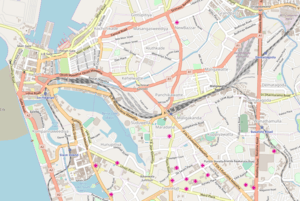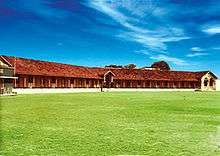Zahira College, Colombo
| Zahira College | |
|---|---|
 | |
| Location | |
 Zahira College Location in central Colombo | |
|
Maradana Sri Lanka | |
| Coordinates | 6°55′38″N 79°51′51″E / 6.927351°N 79.864175°ECoordinates: 6°55′38″N 79°51′51″E / 6.927351°N 79.864175°E |
| Information | |
| Type | Private |
| Motto |
Arabic: Alhamdulillah (Praise be to Allah) |
| Established | 22 August 1892 |
| Founder | Ahmed Orabi, A. M. Wapchi Marikar and M. C. Siddi Lebbe |
| Principal | Triizvy Marikkar |
| Grades | 1–13 (English, Sinhala and Tamil Medium) |
| Gender | Boys |
| Age | 6 to 19 |
| Colour(s) |
Green, white & maroon |
| Alumni | Old Zahirians |
| Website |
zahiracollege |
Zahira College (commonly known as Zahira) (Sinhalese: සහිරා විදුහල, Tamil: சாஹிரா கல்லுரி) is an Islamic school at Colombo in Maradana, Sri Lanka and was founded in 1892 as Al Madrasathul Zahira by a famous Islamic ruler M.C Siddhi Lebbe, with the active patronage of Ahmed Orabi Pasha of Egypt. The college also has one of the oldest mosques in the country in its premises.
The word Zahira means "excellence" in Arabic.
History

The idea of school mainly for Muslims was conceived by prominent individuals at the time, such as Proctor M. C. Siddi Lebbe of Kandy, when circumstances were positively hostile to English education due to the reasons where English education was very much associated with proselytism.[1] At this juncture in history of Sri Lanka almost all the schools in the country were run by Christian missionaries. Because Sri Lanka had not won its independence from the British Empire an almost state aided conversion submerged other communities. Nevertheless, Muslim pioneers in education were more than satisfied that Islam would weather assaults at conversion but that education was essential for the Muslim community’s progress if not its very survival. Thus, due to this and many other pertaining factors, Zahira was established on Monday, 22 August 1892.
Factors influencing establishment
During a public speech made by M. C. Siddhi Lebbe in 1891 at the Maradana Mosque Hall (which later became to be the college mosque), he appealed to the Muslim community to unite and promote the educational advancement of the community. This led to the formation of the Colombo Muslim Educational Society. The first Secretary was I. L. M. Abdul Aziz and Arasi Marikar Wapchie Marikar was the first Treasurer and Head Master. With the help of Ahamed Orabi Pasha, an Egyptian exile in Ceylon and freedom fighter, Al-Madrasathul Zahira was established. In 1894 the school was registered as a grant-in-aid school Maradana Mohammedan Boys School.

Associations

- Old Boys Association
- Past Prefect’s Association
- Zahira College Old Boy’s Rugby Association (ZOBRA)
- Past 1st XI Cricketers Association (PCA)
- Old Zahira Tamil Association (OZTA)
Clubs and Societies
- Arabic Society
- Commerce Society
- English Debating Circle
- English Literacy Association
- Environment Society
- Gavel Club
- Green Zahira
- ICT Society
- Interact Club
- Islamic Society
- Media Unit (Zmedia)
- Science Society
- Shakespeare Drama Club
- Sinhala Debating Circle
- Sinhala Literacy Association
- Unique Zahirianz
Sports
The College has produced a number of football players who represented the national team.
The college swimming pool project was proposed and funded by the Old Boys Association. and it was officially opened for the School Students, Old boys and for the Public (after school hours). The project was initiated in 2010 and successfully completed and opened on 14 July 2012.
The school offers the following sports:
- Athletics
- Basketball
- Cricket
- Football
- Hockey
- Karate
- Rugby
- Swimming
- Boxing
- Basketball
Houses
Students are divided into four houses. The houses are led by House Captains, competing in all major games to win the inter-house games and house colours are awarded winners.
- Angora colour : Green
- Baghdad colour : Blue
- Cordova colour : Orange
- Istanbul colour : Maroon
Headmasters
- Mr. A. M. Wapchie Marikar
- Proctor Mr. N. H. M. Abdul Cader
- Mr. A. S. Abdul Cader
- Mr. S.J.A. Doray
- Mr. Abdul Azeez
Principals
| Name | From | To |
|---|---|---|
| Mr. O. E. Martinus | 1913 | 1914 |
| Mr. J. C. McHeyzer | 1914 | 1920 |
| Mr. T. B. Jayah | 1921 | 1947 |
| Mr. A. M. A. Azeez | 1948 | 1961 |
| Mr. I. L. M. Mashoor | 1961 | 1965 |
| Mr. M. F. M. H. Fakhir | 1965 | 1966 |
| Mr. S. L. M. Shafie Marikar | 1967 | 1982 |
| Mr. R. I. T. Alles (Director of Studies) | 1983 | 1985 |
| Mr. Saheed M. Irshad | 1986 | 1987 |
| Mr. T. D. Hannan | 1988 | |
| Mr. A. Z. Omardeen | 1989 | |
| Mr. A. M. Sameem | 1990 | 1991 |
| Mr. A. Javid Yusuf | 1992 | 1994 |
| Prof. M. T. A. Furkhan | 1995 | 1997 |
| Dr. I. A. Ismail | 1998 | |
| Mr. S. A. R. M. Farook | 1999 | |
| Dr. M. Uvais Ahamed | 2001 | 2006 |
| Mr. T.K. Azoor | 2008 | 2010 |
| Mr. M. H. M. Jiffry | 2010 | 2012 |
| Mr. Trizvii Marikkar | 2013 | Present |
Notable alumni
| Name | Notability | Reference |
|---|---|---|
| V. Anandasangaree | member parliament (Kilinochchi 1970–1983, Jaffna 2000–2004) | |
| A. H. M. Fowzie | member parliament (National List 2015–present, Colombo 1994–2015), Mayor of Colombo 1974–1977 | |
| Mohammed Abdul Bakeer Markar | member parliament (Beruwala 1960–1988), Governor of Southern Province 1988–1993 | |
| Saleem Marsoof | Supreme Court Judge 2005–2014 | |
| S. Z. M. Mashoor Moulana | Senator - Senate of Ceylon | |
| A. J. M. Muzammil | Mayor of Colombo 2011–2016 | |
| Rezvi Sheriff | academic, physician | |
| Karthigesu Sivathamby | emeritus professor (Tamil studies), author |
Gallery
 The Gafoor Hall, Colleges Main Hall
The Gafoor Hall, Colleges Main Hall Zahira College Mosque, also known as the Maradana Mosque. The mosque was established long before the college was started and was patronized by A.M. Wapchie Marikar.
Zahira College Mosque, also known as the Maradana Mosque. The mosque was established long before the college was started and was patronized by A.M. Wapchie Marikar. The Umpichy Building across the college ground
The Umpichy Building across the college ground
References
- ↑ K N O, Dharmadasa. Language, Religion, and Ethnic Assertiveness: The Growth of Sinhalese in Sri Lanka. University of Michigan Press. pp. 126, 254. ISBN 978-0472102884.